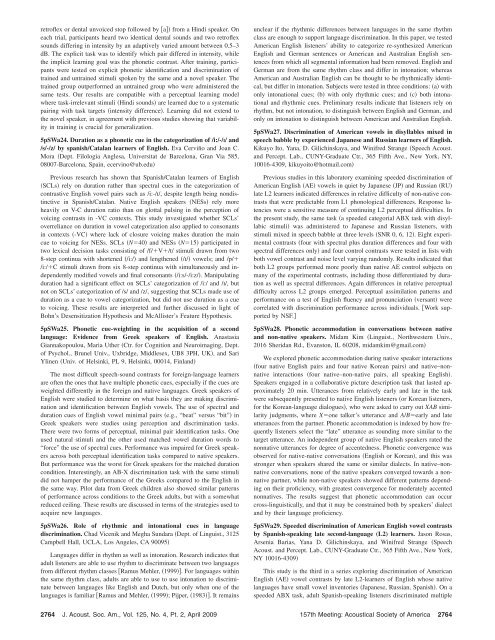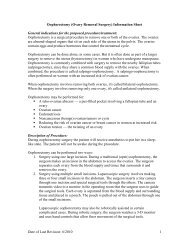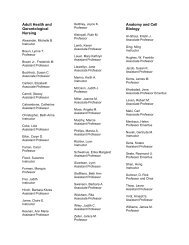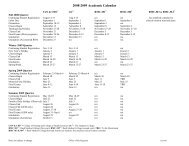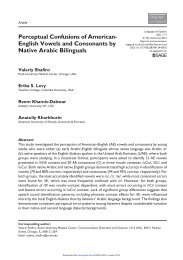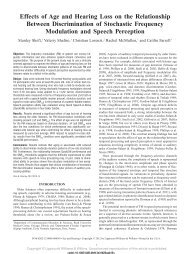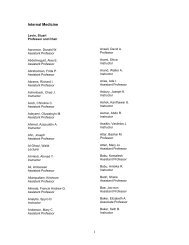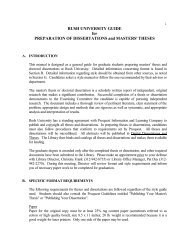Perceptual confusions of American English vowels ... - Rush University
Perceptual confusions of American English vowels ... - Rush University
Perceptual confusions of American English vowels ... - Rush University
Create successful ePaper yourself
Turn your PDF publications into a flip-book with our unique Google optimized e-Paper software.
etr<strong>of</strong>lex or dental unvoiced stop followed by a from a Hindi speaker. On<br />
each trial, participants heard two identical dental sounds and two retr<strong>of</strong>lex<br />
sounds differing in intensity by an adaptively varied amount between 0.5–3<br />
dB. The explicit task was to identify which pair differed in intensity, while<br />
the implicit learning goal was the phonetic contrast. After training, participants<br />
were tested on explicit phonetic identification and discrimination <strong>of</strong><br />
trained and untrained stimuli spoken by the same and a novel speaker. The<br />
trained group outperformed an untrained group who were administered the<br />
same tests. Our results are compatible with a perceptual learning model<br />
where task-irrelevant stimuli Hindi sounds are learned due to a systematic<br />
pairing with task targets intensity difference. Learning did not extend to<br />
the novel speaker, in agreement with previous studies showing that variability<br />
in training is crucial for generalization.<br />
5pSWa24. Duration as a phonetic cue in the categorization <strong>of</strong> /i:/-/(/ and<br />
/s/-/z/ by spanish/Catalan learners <strong>of</strong> <strong>English</strong>. Eva Cerviño and Joan C.<br />
Mora Dept. Filologia Anglesa, Universitat de Barcelona, Gran Via 585,<br />
08007-Barcelona, Spain, ecervino@ub.edu<br />
Previous research has shown that Spanish/Catalan learners <strong>of</strong> <strong>English</strong><br />
SCLs rely on duration rather than spectral cues in the categorization <strong>of</strong><br />
contrastive <strong>English</strong> vowel pairs such as /i:-/(/, despite length being nondistinctive<br />
in Spanish/Catalan. Native <strong>English</strong> speakers NESs rely more<br />
heavily on V-C duration ratio than on glottal pulsing in the perception <strong>of</strong><br />
voicing contrasts in -VC contexts. This study investigated whether SCLs’<br />
overreliance on duration in vowel categorization also applied to consonants<br />
in contexts -VC where lack <strong>of</strong> closure voicing makes duration the main<br />
cue to voicing for NESs. SCLs N40 and NESs N15 participated in<br />
two lexical decision tasks consisting <strong>of</strong> /f/V/t/ stimuli drawn from two<br />
8-step continua with shortened /i:/ and lengthened /(/ <strong>vowels</strong>; and /p/<br />
/i:/C stimuli drawn from six 8-step continua with simultaneously and independently<br />
modified <strong>vowels</strong> and final consonants /i:s/-/i:z/. Manipulating<br />
duration had a significant effect on SCLs’ categorization <strong>of</strong> /i:/ and /(/, but<br />
not on SCLs’ categorization <strong>of</strong> /s/ and /z/, suggesting that SCLs made use <strong>of</strong><br />
duration as a cue to vowel categorization, but did not use duration as a cue<br />
to voicing. These results are interpreted and further discussed in light <strong>of</strong><br />
Bohn’s Desensitization Hypothesis and McAllister’s Feature Hypothesis.<br />
5pSWa25. Phonetic cue-weighting in the acquisition <strong>of</strong> a second<br />
language: Evidence from Greek speakers <strong>of</strong> <strong>English</strong>. Anastasia<br />
Giannakopoulou, Maria Uther Ctr. for Cognition and Neuroimaging, Dept.<br />
<strong>of</strong> Psychol., Brunel Univ., Uxbridge, Middlesex, UB8 3PH, UK, and Sari<br />
Ylinen Univ. <strong>of</strong> Helsinki, PL 9, Helsinki, 00014, Finland<br />
The most difficult speech-sound contrasts for foreign-language learners<br />
are <strong>of</strong>ten the ones that have multiple phonetic cues, especially if the cues are<br />
weighted differently in the foreign and native languages. Greek speakers <strong>of</strong><br />
<strong>English</strong> were studied to determine on what basis they are making discrimination<br />
and identification between <strong>English</strong> <strong>vowels</strong>. The use <strong>of</strong> spectral and<br />
duration cues <strong>of</strong> <strong>English</strong> vowel minimal pairs e.g., “beat” versus “bit” in<br />
Greek speakers were studies using perception and discrimination tasks.<br />
There were two forms <strong>of</strong> perceptual, minimal pair identification tasks. One<br />
used natural stimuli and the other used matched vowel duration words to<br />
“force” the use <strong>of</strong> spectral cues. Performance was impaired for Greek speakers<br />
across both perceptual identification tasks compared to native speakers.<br />
But performance was the worst for Greek speakers for the matched duration<br />
condition. Interestingly, an AB-X discrimination task with the same stimuli<br />
did not hamper the performance <strong>of</strong> the Greeks compared to the <strong>English</strong> in<br />
the same way. Pilot data from Greek children also showed similar patterns<br />
<strong>of</strong> performance across conditions to the Greek adults, but with a somewhat<br />
reduced ceiling. These results are discussed in terms <strong>of</strong> the strategies used to<br />
acquire new languages.<br />
5pSWa26. Role <strong>of</strong> rhythmic and intonational cues in language<br />
discrimination. Chad Vicenik and Megha Sundara Dept. <strong>of</strong> Linguist., 3125<br />
Campbell Hall, UCLA, Los Angeles, CA 90095<br />
Languages differ in rhythm as well as intonation. Research indicates that<br />
adult listeners are able to use rhythm to discriminate between two languages<br />
from different rhythm classes Ramus Mehler, 1999. For languages within<br />
the same rhythm class, adults are able to use to use intonation to discriminate<br />
between languages like <strong>English</strong> and Dutch, but only when one <strong>of</strong> the<br />
languages is familiar Ramus and Mehler, 1999; Pijper, 1983. It remains<br />
unclear if the rhythmic differences between languages in the same rhythm<br />
class are enough to support language discrimination. In this paper, we tested<br />
<strong>American</strong> <strong>English</strong> listeners’ ability to categorize re-synthesized <strong>American</strong><br />
<strong>English</strong> and German sentences or <strong>American</strong> and Australian <strong>English</strong> sentences<br />
from which all segmental information had been removed. <strong>English</strong> and<br />
German are from the same rhythm class and differ in intonation; whereas<br />
<strong>American</strong> and Australian <strong>English</strong> can be thought to be rhythmically identical,<br />
but differ in intonation. Subjects were tested in three conditions: a with<br />
only intonational cues; b with only rhythmic cues; and c both intonational<br />
and rhythmic cues. Preliminary results indicate that listeners rely on<br />
rhythm, but not intonation, to distinguish between <strong>English</strong> and German, and<br />
only on intonation to distinguish between <strong>American</strong> and Australian <strong>English</strong>.<br />
5pSWa27. Discrimination <strong>of</strong> <strong>American</strong> <strong>vowels</strong> in disyllables mixed in<br />
speech babble by experienced Japanese and Russian learners <strong>of</strong> <strong>English</strong>.<br />
Kikuyo Ito, Yana, D. Gilichinskaya, and Winifred Strange Speech Acoust.<br />
and Percept. Lab., CUNY-Graduate Ctr., 365 Fifth Ave., New York, NY,<br />
10016-4309, kikuyoito@hotmail.com<br />
Previous studies in this laboratory examining speeded discrimination <strong>of</strong><br />
<strong>American</strong> <strong>English</strong> AE <strong>vowels</strong> in quiet by Japanese JP and Russian RU<br />
late L2 learners indicated differences in relative difficulty <strong>of</strong> non-native contrasts<br />
that were predictable from L1 phonological differences. Response latencies<br />
were a sensitive measure <strong>of</strong> continuing L2 perceptual difficulties. In<br />
the present study, the same task a speeded categorial ABX task with disyllabic<br />
stimuli was administered to Japanese and Russian listeners, with<br />
stimuli mixed in speech babble at three levels SNR0,6,12. Eight experimental<br />
contrasts four with spectral plus duration differences and four with<br />
spectral differences only and four control contrasts were tested in lists with<br />
both vowel contrast and noise level varying randomly. Results indicated that<br />
both L2 groups performed more poorly than native AE control subjects on<br />
many <strong>of</strong> the experimental contrasts, including those differentiated by duration<br />
as well as spectral differences. Again differences in relative perceptual<br />
difficulty across L2 groups emerged. <strong>Perceptual</strong> assimilation patterns and<br />
performance on a test <strong>of</strong> <strong>English</strong> fluency and pronunciation versant were<br />
correlated with discrimination performance across individuals. Work supported<br />
by NSF.<br />
5pSWa28. Phonetic accommodation in conversations between native<br />
and non-native speakers. Midam Kim Linguist., Northwestern Univ.,<br />
2016 Sheridan Rd., Evanston, IL 60208, midamkim@gmail.com<br />
We explored phonetic accommodation during native speaker interactions<br />
four native <strong>English</strong> pairs and four native Korean pairs and native–nonnative<br />
interactions four native–non-native pairs, all speaking <strong>English</strong>.<br />
Speakers engaged in a collaborative picture description task that lasted approximately<br />
20 min. Utterances from relatively early and late in the task<br />
were subsequently presented to native <strong>English</strong> listeners or Korean listeners,<br />
for the Korean-language dialogues, who were asked to carry out XAB similarity<br />
judgments, where Xone talker’s utterance and A/Bearly and late<br />
utterances from the partner. Phonetic accommodation is indexed by how frequently<br />
listeners select the “late” utterance as sounding more similar to the<br />
target utterance. An independent group <strong>of</strong> native <strong>English</strong> speakers rated the<br />
nonnative utterances for degree <strong>of</strong> accentedness. Phonetic convergence was<br />
observed for native-native conversations <strong>English</strong> or Korean, and this was<br />
stronger when speakers shared the same or similar dialects. In native–nonnative<br />
conversations, none <strong>of</strong> the native speakers converged towards a nonnative<br />
partner, while non-native speakers showed different patterns depending<br />
on their pr<strong>of</strong>iciency, with greatest convergence for moderately accented<br />
nonnatives. The results suggest that phonetic accommodation can occur<br />
cross-linguistically, and that it may be constrained both by speakers’ dialect<br />
and by their language pr<strong>of</strong>iciency.<br />
5pSWa29. Speeded discrimination <strong>of</strong> <strong>American</strong> <strong>English</strong> vowel contrasts<br />
by Spanish-speaking late second-language (L2) learners. Jason Rosas,<br />
Arsenia Barias, Yana D. Gilichinskaya, and Winifred Strange Speech<br />
Acoust. and Percept. Lab., CUNY-Graduate Ctr., 365 Fifth Ave., New York,<br />
NY 10016-4309<br />
This study is the third in a series exploring discrimination <strong>of</strong> <strong>American</strong><br />
<strong>English</strong> AE vowel contrasts by late L2-learners <strong>of</strong> <strong>English</strong> whose native<br />
languages have small vowel inventories Japanese, Russian, Spanish. Ona<br />
speeded ABX task, adult Spanish-speaking listeners discriminated multiple<br />
2764 J. Acoust. Soc. Am., Vol. 125, No. 4, Pt. 2, April 2009 157th Meeting: Acoustical Society <strong>of</strong> America 2764


